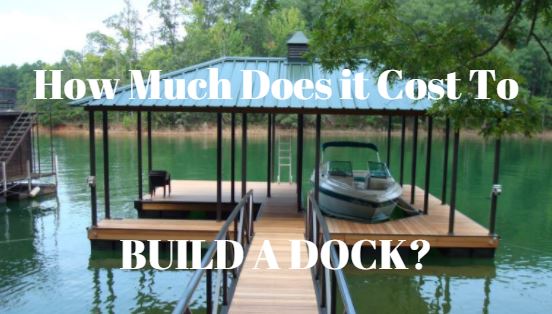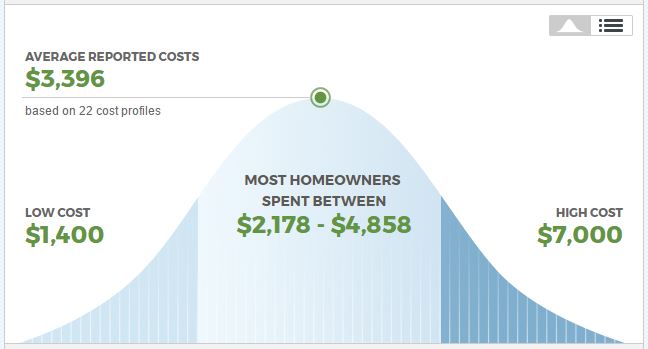
Building a dock is a large-scale project for many homeowners. It involves considerable planning and decision-making prior to starting construction. Choices must be made regarding the type of dock, materials used, electrical capabilities and budget. Other considerations, like permits and inspection, should also be taken into account. Many of these factors will vary considerably.
Original Article by Homeadvisor.com.
The Cost to Build a Boat Dock
The costs associated with dock construction are extremely variable. Prefabricated or assembled docks can be as cheap as $1,000 while high-quality permanent docks can cost between $50,000 and $75,000, depending on the difficulty of installation, water depth, climate, and other factors. Selecting the type of dock to construct on a lakefront home may be the biggest decision homeowners make during this process. Ultimately, this is what will determine the total project cost.
A floating dock is constructed by placing decking over airtight barrels or drums. These float and can accommodate a certain amount of weight on top of them. The amount of weight the dock can bear is influenced by the size and number of barrels used in construction along with the type and weight of the decking. A floating dock may cost between $20 and $35 per square foot, depending on the choice of decking.
Compared to other styles, a floating dock has advantages and disadvantages. These docks tend to be less expensive, and they can easily be removed from the water during the winter with a little planning. Their repair and upkeep tend to be manageable as well. Unfortunately, floating docks are less stable. They move with the flow of water, which makes them suited for use with water levels that rise and fall, but not with moving water, such as rivers and creeks.
Piling Docks
Piling docks are constructed by driving pilings, generally robust wooden beams with a cylindrical appearance, into the lakebed. The decking is connected to the pilings to form a structurally sound and attractive dock. Estimates vary, but in general, homeowners should budget for between $20 and $40 per square foot for a basic piling dock and more for one with aesthetic features or high-end construction.
They are more expensive than floating docks due to the added difficulty of installation. Piling docks are permanent and durable if maintained properly. They also offer homeowners more options to customize the dock. Adding electrical for a boatlift or mooring system is a possibility here.
Pipe Docks
A pipe dock is a less expensive version of a piling dock. It uses pipes instead of wooden pilings to support the decking. They are installed in much the same way but often at a lower cost. This type is best suited for shallow water and clement weather. A prefabricated pipe dock will cost between $1,000 and $2,000, but that does not include installation. A budget in the neighborhood of $3,000 to complete the project should suffice.
Using a pipe dock can save on the cost of materials; however, it may not be as sturdy as a piling dock especially if the water level changes seasonally or the water freezes during the winter. If the dock is primarily used for fishing or lounging, a pipe dock may be perfectly suitable. As a boating dock, this type may not be satisfactory.
Crib Docks
Crib docks are constructed by filling a large container with rocks and covering it with decking that connects to the shoreline. These are potentially difficult to build due to environmental regulations and possibly unsuited to water more than 10 to 15 feet deep. Costs are variable and depend on the size of the crib, amount of decking and boardwalk, and installation. In general, crib docks are among the most expensive.
They have the advantages of easy upkeep and permanence. A crib dock is almost like a man-made island, except for the wooden, underwater frame that holds it together. A well constructed crib dock has the potential to outlast the lifetime of its owner, but that largely depends upon its initial quality. Local regulations may not allow for the construction of a crib dock or may limit its size. Homeowners should check with zoning boards or other entities prior to beginning any construction.
Suspension Docks
A suspension dock is built to overhang the water, like a suspension bridge, with anchorage and cable. These are relatively uncommon in part due to the engineering challenges involved in their construction and overall expense. An added expense for this dock type, above materials or installation, is the engineering and design required to create plans for a safe and functional suspension dock. This is even more necessary if the dock is cantilevered. For the best budgeting outcome, homeowners should consider the towers and cabling separately from the dock itself in order to gauge costs accurately.
Suspension docks have positive and negative features. The two biggest positives are that the dock has low environmental impact and high aesthetic value. In terms of the negative, they are expensive and may require longer to plan and construct due to their complexity. They are good for areas with a fragile underwater ecosystem and variable water levels.
Running Electrical to the Dock for Mooring or Lifting
Readily available dockside electricity can be a serious benefit especially for the owners of larger boats who desire mooring and lifting features with their new dock. Electrical can also be used for added lighting. Overall, the cost of running electricity to a dock is generally not the largest line item in the budget, but it can cost up to $1,000. A boatlift will add between $5,000 and $7,000 to the project.
Dock Materials
The majority of docks are constructed with wooden or plastic decking along with the specific materials that are required for that dock type. Floating docks require drums, and piling docks require wooden beams for example. Treated and stained lumber is preferred for decking because the dock will likely have contact with both sunlight and water. The environmental impact of pre-treated lumber is currently a topic of much debate; however, for dock types where the wood has minimal contact with the water, this is much less of an issue.
Some Considerations When Choosing a Dock
Homeowners should take into account the regulations regarding dock construction in their area. These will influence the type of dock that can be built. The climate will be another factor. In areas where lakes freeze in the winter, some types, including pipe docks, may not work very well and would be prone to damage. Flooding can also be an issue. Another consideration is the depth of the water. Deep water may necessitate the use of piling docks or suspension docks instead of crib docks. Budget plays a role as well. Many homeowners may not wish to spend the amount necessary to build a suspension or crib dock.
A dock can add value and enjoyment to waterside properties and lakefronts, allowing for easy access to the water for boating and fishing. Building a dock is a big project, but homeowners shouldn’t be daunted.
RePosted by Scott Freerksen “The Lake Guy

